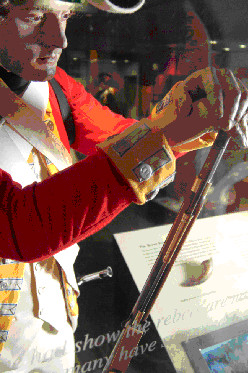Recently, I received an e-mail from a Lincolnite reader who asked if I could explore the origins of the term “yellowbelly”, which as we know is used to denote someone born and bred in Lincolnshire.
Having heard the usual stories and looked deeper into its meaning, I have come across countless claims to its origins. While impossible to truly pin down the term’s starting point, I will share a few of my favourite stories for why us Lincolnites are called yellowbellies.

The Royal Lincolnshire Regiment and Royal Lincolnshire Militia are both believed to have sported yellow on their uniform.
Perhaps the most popular story for the origins of the term yellowbelly is one concerning the apparel worn by local regiments. According to the story, officers in the Royal Lincolnshire Militia, who were stationed at what is now the Museum of Lincolnshire Life, wore waistcoats which were bright yellow in colour. According to the story, this made the officers much more visible to their troops in the field.
In another version of the tale, soldiers in the Lincolnshire Regiment (which was formed in 1685 and saw action throughout the world, including the American Revolution, the battle of Blenheim, the Napoleonic Wars and the two World Wars) wore a uniform of green, which featured yellow facings and yellow buttons on their coats.
Several other tales revolve around the people of the county as the reason for the term. One such tale states that farmers often worked their fields shirtless during the summer. Due to the large amounts of bending during their work their backs would become bronzed with the sun, but their stomachs would remain pale and have a yellow appearance to them.
Another story derogatorily stated that dwellers of the Fens would often crawl around on their stomachs, with their clothes gaining a yellow belly as a result. Yet another origin myth, again tied to the Fens, states that the opium used to combat malaria that was prevalent in the area in earlier times often gave the skin a strange yellow tinge, hence yellowbelly.
A popular tale for the creation of the term relates to the old stagecoaches, which connected the city to the wider country (particularly London and York). According to the story, the carriages featured a distinctive yellow paint scheme and upon their arrival in another city locals were reputed to say, “here comes the Lincolnshire yellowbelly”.

It’s thought a certain kind of newt common in the Lincolnshire Fens had a yellow belly. Photo:
Besides the inhabitants and vehicles of the county, there are also several tales relating to the wildlife of Lincolnshire being the cause for the name. The traditional sheep of the county, the Lincoln Longwool, supposedly provided the inspiration for the term, as its grazing through mustard plants resulted in its thick wool being stained yellow. There are also tales that the term derives from the frogs and newts of the Fens, who feature bright yellow abdomens.
It seems that there are as many origins for the wonderful phrase ‘yellowbelly’ as there are days in the month. While I would have liked to have provided every single story, it simply couldn’t be done; partially because of the sheer number of them and because I simply do not know them all.
I would therefore love to hear from you all. Do you have a favourite story of the origin of yellowbelly, or do you know any other tales? Please join in the discussion in the comments, the Lincolnite Facebook page, or on Twitter (use the hashtag #yellowbelly).







